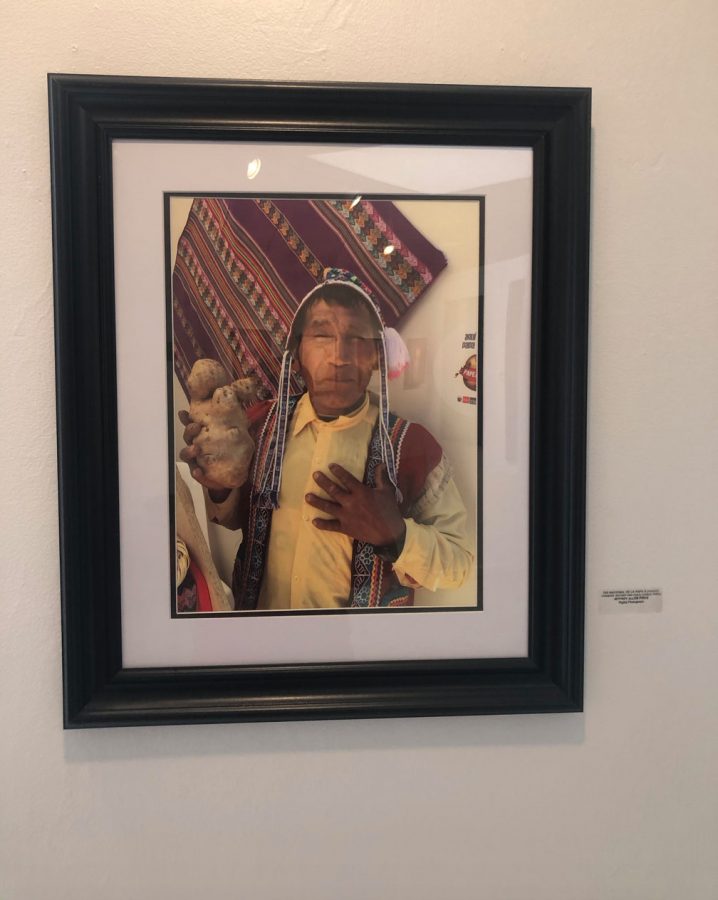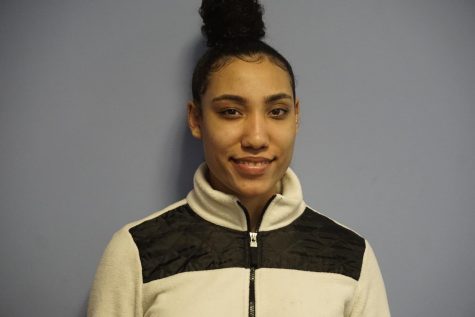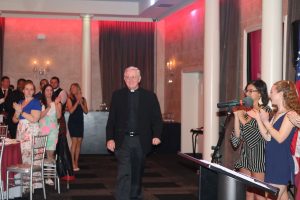Art exhibit showcases faculty talent
“Dia Nacional De La Papa” by Price is on display at the Bother Kenneth Chapman Gallery.
October 31, 2019
The Counsel on the Arts is hosting the Visual Arts Faculty Exhibition from Oct. 15 through Dec. 5 in the Brother Kenneth Chapman Gallery.
The gallery displays artwork developed by faculty featuring Brother Kenneth Chapman, Jeffrey Price, Thomas Ruggio and Ryan Seslow. The artworks include photography, sculptures and paintings.
The spotlight highlights Thomas Ruggio, an assistant professor of liberal arts, director of the visual arts and founder of the Buggo Art Program;and Jeffrey Price, adjunct professor, also known as the “Potato Artist.”
These interviews have been edited for space and clarity.
Thomas Ruggio
– Can you give me the run down on what your role is on campus?
I am the full-time assistant professor of the liberal arts, so I teach studio art and art history and I’m considered to be the director of visual arts. I’m teaching, dealing with some administrative work, but for the most part, my focus is teaching here and trying to change and expand the program.
– How do you connect your passion for art with you career here at Iona?
Just by being here, I have connected it. This is what I love to do. I think I love teaching as much as or maybe even more than creating art, so when I’m teaching here or when I’m with students, that’s my at least [first] passion and [my second] would be creating artwork, so being here at Iona sort of affords me to stay in the realm of being an artist, being a professional in this field, but also teaching students about this.
– Can you tell me a little about the studio Borgo art program in Lucca, Italy?
Well, I thought there was an opportunity to start an art program in a part of a very historic region of Italy called Tuscany. An hour north of Florence is the city of Lucca, which is where I live when I’m not in New York. I began the program there to introduce drawing and painting techniques and the local history to anyone who wanted to come. While the workshop is not accredited, I’ve worked with colleges to work within their curriculum or structure with study abroad classes or faculty development, so I’ve worked with other institutions. But it’s essentially for anyone who wants to study drawing and painting and experience sort of a real cultural emersion, because it’s not a very commercial or touristy part of the region.
– You have studied the ‘Old Masters’?
The Old Masters are artists that everyone knows like Leonardo da Vinci, Michelangelo and Raphael. I also teach studio art and art history, so living [in Lucca] got me closer where I was able to experience works of art and sites first-hand in a way that I probably couldn’t if I only lived in the states. So that certainly helped my education and my ability to teach about these subjects.
– Can you go in depth about how your experience in Italy and how your studies of the Old Masters influenced your works here in the exhibit?
I think with studying the Old Masters, I always think about the old facets of my purpose here as an educator. As I said, I teach studio art, I also teach techniques that are somewhat consistent with the Old Masters. In painting, our techniques are a bit more modern then the masters worked, they worked with sometimes layers of glazing like Leonardo da Vinci. We do more of an opaque application with acrylic paint because we are not working with oils here. So, we are working with a slightly more modern incarnation. My work was not influenced by the Old Masters, but by the 19th century masters who are considered modern such as the impressionists and artists that have worked in the “En plein air” method. That’s a French term, which means “In open air.” I never worked like that before until I moved to Italy and started my art program there, so I was influenced by the 19th century “En plein air” painters, but I was also inspired by the view.
– What drives your passion for art?
I think it was from when I was a little boy, it was apparent that I could draw very well, better than most apparently. When I got to school, they would make a big deal out of everything I did. When your parents praise you, it’s not a big deal, but then everyone started to react very strongly to it and I won a competition, the Energy Conservation. I got to meet the governor, and I was just a kid. So, it almost seemed like the path was almost laid out for me in a way. But I had a lot to learn, so I began to study and work on techniques.
– Is there anything that you would like to add?
Well, I developed a course, I co-wrote it with Professor Thomas Donnarumma, who is the chair of the FPA department, that is a study abroad course which is running through the spring. That’s pretty exciting because it is going to take place in my backyard, essentially, Lucca, but we are also going to go to Florence and some other cities in Tuscany, and students from Iona are going to have the opportunity to see sites and artworks like Michelangelo’s “David” and things like that first-hand.
Jeffrey Price
–Why potatoes?
That’s always the first question. It started around 1996, I had been a vegetarian for a couple of years and potatoes were like a main food for me at the time. I was studying painting and I had recently been at the Van Gogh Museum at Amsterdam and I saw his masterpiece, “The Potato Eaters.” Something about that painting worked its way inside me. I was getting more interested in the painting style of social sculpture, the idea of art being able to sculpt society, so potatoes somehow became the theme that I work with. What I realized is that it has a wide range of meaning, I call it the “potato art spectrum.” That on one end, potatoes have a serious side, being the most nutritious vegetable on earth and having an incredible amount of diverse uses along with a comedic side on the other side of the spectrum. Like the terms “couch potato,” “potato head,” comedians using potatoes as a funny word. Through my research I find the potato as something that is culturally ambiguous and I find it interesting and funny.
– How do you think potatoes affect our lives, what big impact do they have?
Four words: earthy, healthy, humble and versatile. Those are the some of the symbolisms I have for the potato. Other common themes I see with them are familial and community, those are some of the related ideas to the potato which is why I think it’s so important culturally. Potatoes have propelled nations, it has helped populations expand and unfortunately has even propelled wars. In fact, potatoes go to other things besides consumption, such as making alcohol and fuel. I can go on and on. It’s an amazingly efficient food, so I think that’s why it’s important globally and economically.
– Can you tell me a little bit about the Think Potato Institute?
It’s the collection of potato-related objects that I own, which is about 6,000 objects now. But I also consider it any events that I host or organize. Sometimes I give workshops on how to do potato stamps or I might give an art history talk on potatoes. I call it the institute because it’s like an organization that has many disciplinary ideas.
– How do you bring potatoes into the classroom?
My students always bring it into the classroom because they always ask me about it. For example, in my art history class, I could give a lecture on the history of art with the potato, like the first artwork known using potato in Peru, or the development of herbal painting in Europe. I also include Vincent van Gogh or these early 19th century artists who were interested in painting peasant pictures with potatoes. The easy way I bring it into the classroom is by doing workshops about the potato. I’m also writing a book on the history of art with potato, so I can say that is my major way of bringing into the art classroom.
– How do you like your potatoes?
All of the above. To be honest, I have been asked this question many times, I guess it depends on my mood, my typical answer is mashed potatoes. But what I like is trying indigenous ways of eating potatoes. So, if you were to ask me what my favorite indigenous way I have eaten a potato is when in Peru, the indigenous grew this exotic colorful potato, cooking them underground by placing the potatoes with their seasoning herbs on hot stones, covering the potatoes with earth and blankets allowing them to cook underground. That is the coolest way I have ever had potato.









